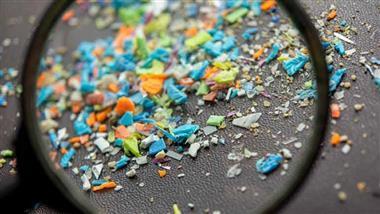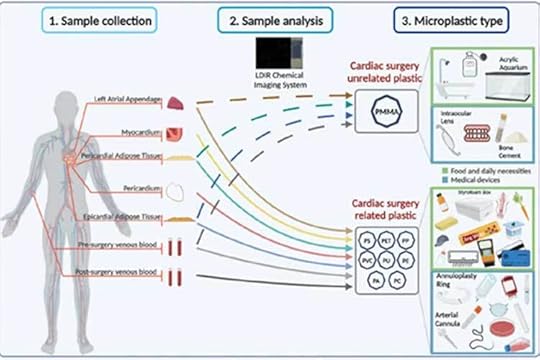Scientists Discover Microplastics in Heart and Brain Tissues

Dr Mercola
Story at-a-glanceDiscarded plastic — both large and microscopic — circles the globe, choking our oceans and polluting our food supply, ultimately finding their way into your body where they can accumulate over timeScientists have detected microplastic in all kinds of human tissues, including the placenta, lungs, spleen, liver, kidney, heart, brain and stool. In 2022, Dutch scientists also confirmed the presence of microplastics in meat and milk, as well as the blood of both farm animals and humansAustrian researchers found plastic microparticles migrate into the brains of mice within two hours of drinking water contaminated with microplastic. Once in the brain, these plastic microparticles can increase the risk of inflammation, neurological disorders or neurodegenerative diseases such as Alzheimer’s. Other recent research found it can trigger behavioral changes akin to dementia in as little as three weeksMicroplastics are toxic to cells. Research shows microplastic particles enter cells within 24 hours of exposure and primarily accumulate around the nucleus of the cell. As levels of microplastics and exposure time increase, cell viability significantly decreasesChinese scientists discovered microplastics in the heart tissue of 15 patients undergoing cardiovascular surgery, and some of this plastic appears to be introduced during the surgery itselfWe live in a throwaway society. The next time you’re in a grocery store, take a look around you and note the number of items packaged in plastic. The problem is, many of these petroleum-based plastics will last forever. So we have products for short-term consumption packaged in materials that survive for centuries, endangering wildlife and human health alike all the while.
Discarded plastic — both large and microscopic — circles the globe, choking our oceans and polluting our food supply, ultimately finding their way into your body where they can accumulate over time. In recent years, scientists have detected microplastic in all kinds of human tissues, including the placenta,1 lungs, spleen, liver, kidney, heart, brain2 and stool.
In 2022, Dutch scientists also confirmed the presence of microplastics in meat and milk, as well as the blood of both farm animals and humans.3,4 In all, nearly 80% of meat and dairy products tested contained microplastics. Shockingly, it was revealed that many feed producers will use expired food products in their processing — with the plastic packaging left on!
Microplastic Rapidly Enters Your BrainIn May 2023, The Guardian reported5 on Austrian research,6,7 which found plastic microparticles migrated into the brains of mice within two hours of drinking water contaminated with microplastic.
“Using computer models to track the dispersion of the plastics, researchers found that nanoplastic particles — which are under 0.001 millimeters and invisible to the naked eye — were able to travel into the mice’s brains via a previously unknown biological ‘transport mechanism,’” The Guardian wrote.
“Essentially, these tiny plastics are absorbed into cholesterol molecules on the brain membrane surface. Thus stowed away in their little lipid packages, they cross the blood-brain-barrier — a wall of blood vessels and tissue that functions to protect the brain from toxins and other harmful substances.”
Once in the brain, these plastic microparticles “could increase the risk of inflammation, neurological disorders or even neurodegenerative diseases such as Alzheimer’s or Parkinson’s,” the researchers warned, and these concerns were recently echoed by scientists at the University of Rhode Island.
Microplastics Trigger Dementia-Like Behavioral ChangesThe research, published in the August 2023 issue of the International Journal of Molecular Sciences,8 showed that microplastics extensively infiltrate the body, including the brain, and can trigger behavioral changes akin to dementia in as little as three weeks.
Here, young and old mice (4-month-olds and 21-month-olds) were exposed to varying levels of microplastics in their drinking water for three weeks. During behavioral testing at the end of the three weeks, many of the animals were found to exhibit dementia-like behavior.
The changes were more pronounced in older animals, which the researchers theorized might be due to “age-related dysfunction exasperating the effects of the PS-MPs [polystyrene microplastics] on behavioral performance.” Lead researcher Jaime Ross called the finding “striking,” because “These were not high doses of microplastics.”
[…]Microplastics May Speed Onset of Neurodegenerative DiseaseAs explained in the paper,10 GFAP is found in mature astrocytes (cells found in your brain and spinal cord), and is involved in cellular processes such as autophagy, neurotransmitter uptake and astrocyte development. GFAP is commonly used as a marker for neuroinflammation.
Oddly enough, GFAP levels were slightly lower in the mice that had been exposed to microplastics, compared to controls, which is atypical if inflammation is part of the problem.
However, the authors pointed out that previous studies have found that “GFAP expression might decrease in early stages of certain diseases, such as Alzheimer’s disease, or in younger patients with disorders such as Major Depressive Disorder.”
Such studies suggest that “early pathology/early onset of disease may be characterized by astrocyte atrophy (as opposed to astrocyte hypertrophy later on), which may result in decreased GFAP expression.”
Microplastics Are Cytotoxic and Boost InflammationThe International Journal of Molecular Sciences paper11 also concluded that microplastics are cytotoxic, which means they’re toxic to cells. The microplastic particles were found to enter cells within 24 hours of exposure, and primarily accumulated around the nucleus of the cell. And, as levels of microplastics and exposure time increased, cell viability significantly decreased.
They also found alterations in immune markers. For example, expression of tumor necrosis factor (TNF-a), an inflammatory cytokine, was two-fold higher in the livers of exposed mice, compared to unexposed controls.
Weathered Plastic Triggers More Severe Inflammatory ResponseIn another recent experiment, researchers looked at the impact of weathered microplastics on human brain cells, compared to brand-new plastic, showing microplastic that has been degraded by environmental exposure causes a more severe inflammatory response.
[…]
This could have important implications for human health, considering a significant portion of the microplastic we consume is through food. Plastic trash in the oceans degrade into microplastic through photosynthesis (exposure to the sun), and those bits are then consumed by fish that end up on our dinner plates.
Microplastics Accumulate in Your Blood and HeartChinese scientists also recently discovered microplastics in the heart tissue of 15 patients undergoing cardiovascular surgery.14
[…]
The following graphic showing where the various plastic particles were found, and their potential sources, was published by the New York Post, August 12, 2023.16 While this study did not theorize about plastic’s contribution to heart disease, considering its impact on inflammation and cell viability, it’s certainly feasible that it could be a contributing factor.
 Plastic Exposure Adds Up
Plastic Exposure Adds UpIn late 2020, research by the World Wildlife Federation International estimated that the average person consumes about 5 grams of plastic every week, which is about the weight of a credit card.17
In the average lifetime, a person will consume about 40 pounds of microplastic. While much of this will pass through you, some will remain and accumulate in your organs.Over time, that really adds up. According to the WWF’s calculations,18 each month, you consume about 21 grams, or the equivalent of one Lego brick. In a year’s time, you’ve consumed 250 grams, or the size of a full dinner plate’s-worth of plastic.
In 10 years, you’ve ingested some 5.5 pounds, and in the average lifetime, a person will consume about 40 pounds. While much of this will pass through and be eliminated through your stool, some will remain and accumulate in your organs.
How to Lower Your Microplastic ExposureConsidering much of the microplastic in your body comes from food and water, it would be wise to use a high-quality water filtration system for your home, and opt for organic grass fed and grass finished meats whenever possible.
Avoid any meats or animal products from livestock (or farmed fish) that have been fed feed pellets, as these can contain microplastic from food packaging that have been processed in. Also, try to reduce your plastic consumption and generation of plastic trash in general.
[…]
Via https://articles.mercola.com/sites/articles/archive/2023/09/11/microplastics.aspx
The Most Revolutionary Act
- Stuart Jeanne Bramhall's profile
- 11 followers



